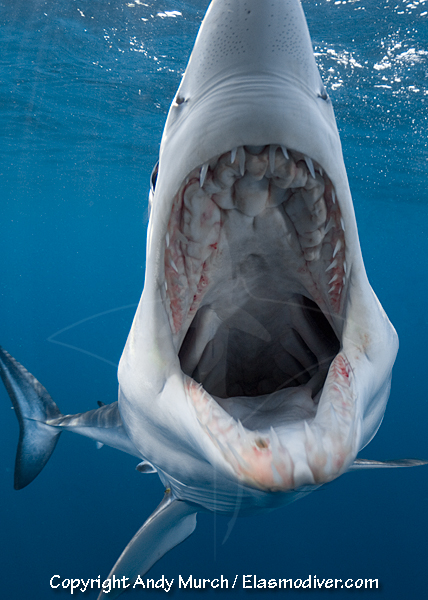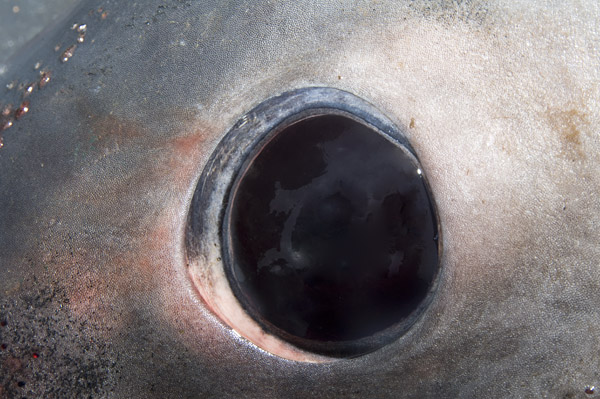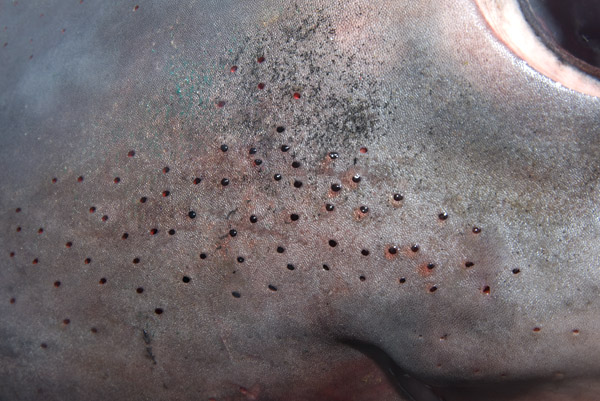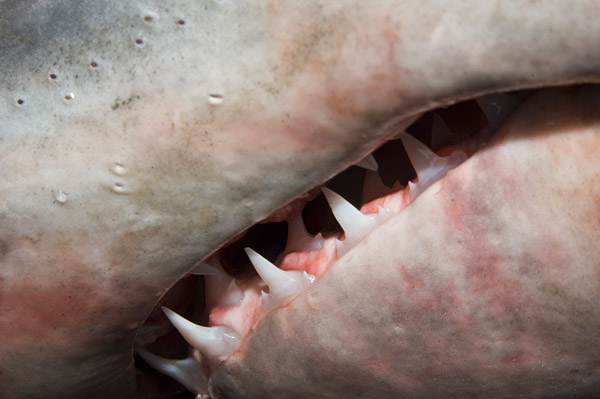
Sharks and rays possess
highly acute senses to interpret their
surroundings. As a group they have maximized their potential habitats by
adapting their senses to function in often adverse conditions such as dark or turbid water.
Their
sensory organs fit (sometimes loosely) into the six categories of sight, hearing, taste, touch,
smell, and electroreception.
Smell:
The olfactory ability in sharks
is well known, although the idea that sharks are able to detect and follow a
drop of blood diluted in the ocean over many miles is an exaggeration.
Sharks possess a pair of nares,
nostril-like holes that are located just under the leading edge of the snout. Each nare is
divided by a nasal flap into two openings. Water is channeled into the incurrent
aperture and having passed over the olfactory lamellae exits the olfactory sac
through the excurrent aperture. The olfactory lamellae are a series of folds on
the interior surface of the olfactory sac which increase the surface area giving
the shark more opportunity to register smells.
Odors passing over the olfactory lamellae stimulate the cilia-like endings of
neuro-sensory cells. What actually happens is, dissolved molecules transported
along in the water column bind to receptor cells which then send a signal to the
brain. This is referred to as a chemosensory function.
Sharks have olfactory bulbs which
are anterior extensions of the large olfactory lobe in the fore-brain that lead
directly into the olfactory sacs. fibers in the olfactory bulb continue directly
into the olfactory tract. With such advanced hardware it is not surprising that
sharks are able to detect fish extracts in concentrations lower than 1 part in
10 billion!
Once a shark picks up a scent
trail it swims up the trail moving its head from side to side (which is its
natural swimming motion). As its snout passes backwards and forwards through the
scent trail it is able to determine the direction from which the odor is
emanating. If the scent is lost or if the slick is too wide to use for
navigation, the shark may swim forward in an exaggerated S pattern until it can
pick up the direction again.
The nares are completely seperate
from the mouth and throat and therefore do not aid at all in respiration. In
order to detect odors, sedentary species are able to pump water over the nares
whilst resting on the sea floor. Not all sharks require a highly developed
olfactory system. Whilst sense of smell may be the prime hunting tool for an
Oceanic whitetip shark swimming along in the featureless ocean, an angel shark
laying in wait for a meal is primarily a visual predator and consequently its
olfactory sense is not so finely tuned. However, odor detection is not only used
in hunting. Sharks and rays produce pheromones which signal their reproductive
state to potential mates and smell may also be used in navigation.
Oceanic whitetip sharks have been
seen with their snouts out of the water supposedly sniffing the air. This may
allow them to detect odors over far greater distances than would be possible
under water.
Vision:

Eye of a Porbeagle Shark
Many
sharks depend heavily on their vision whilst hunting although there are
occasions where the eyes play little or no role at all such as when a
hammerhead is searching for a stingray which is completely buried. In the
majority of species, the eyes are well developed, large, and complex
structures. Some species are also able to sense
light and dark through a thin area of skin on top of the head which leads directly to
the pineal gland in the brain. As there is no lens to focus the light there is
no shape perception but the shark may be able to use the differing
light levels to time its vertical migration throughout the day.
Many shallow water sharks are
able to regulate the amount of light entering their eyes by dilating or
contracting their pupils in the same manner that we do. In some species this is
done laterally whereby the sharks eyes resemble those of a cat. However in some
skate and ray species the pupil contracts into a horseshoe shaped slit. This
creates a kind of double vision which the skate or ray can use to determine
distance. Some species use a different technique all together. They have a
ragged flap which slides over the pupil effectively blocking out much of the
light entering the eye. This flap produces multiple images similar to
those produced by the crescent shaped pupil and again aids in depth
perception.
Focusing in sharks is
accomplished with the aid of the rectus muscles which pull the lens closer to or
further away from the retina just as a camera lens focuses. This differs from
higher vertebrates in which the lens is distorted in order to focus light from
different distances. These muscles combined with the oblique muscles also
control the direction that the eye faces.
Due to the poorly lit environment
in which some deep water sharks live, they lack the ability to stop light from
entering their eyes. This inability to shroud their eyes from intense light may
explain why sixgills are seen in shallower water more regularly in the summer;
as this is the time of higher concentrations of suspended plankton near the
surface creating a darker shallow water environment. Sixgills and other species
such as the Bigeye thresher shark have very large eyes and not surprisingly have
no cones for sensing color. There are however somewhere in the region of twenty
species of sharks that do possess both rods and cones in their eyes. But, the
question regarding a shark's ability to tell one color from another is still
undecided. Dr. Eugenie Clark once performed a test on lemon sharks that
she had trained to push a white panel lowered into their pen at which point they
were rewarded with food. At one feeding the panel color was substituted for a
yellow one at which point the approaching Lemon shark almost back flipped in the
water and refused to ever eat again. Whether this proves that the shark was able
to determine the change of color or whether the slight change of brightness was
responsible for its behavior is not clear.
Most sharks possess excellent
vision in low light conditions. The structure in the eye responsible for this is
called the tapetum lucidum. This is a layer composed of mirrored crystals which
lay behind the retina that can be adjusted to reflect light back onto the retina
amplifying the strength of the image. Sharks share this ability with some
nocturnal mammals and reptiles which require extremely sensitive vision to
survive.
Unlike bony fishes sharks do
possess eyelids (both upper and lower) but they are fixed and unable to cover
the eye. Requiem sharks have developed a toughened layer known as the
nictitating membrane that rises from below the eye to completely cover it during
feeding rendering the shark blind from a purely sight oriented perspective.
White sharks and some others that do not possess a nictitating membrane are able
to roll their eyes back in their sockets protecting the pupils and exposing a
hardened pad on the back of the eye.
White sharks have been seen
to lift their heads out of the water far enough to get a look at their topside
surroundings. This behavior has been witnessed in the presence of boats but
possibly developed from the sharks desire to determine whether seals or sea lions
are present in the area. It is unclear how well their eyes are adapted to above
water vision.
Touch:
Touch can be split into actual contact and distant touch experienced through
the lateral line system. Many sharks will nose an object prior to biting it in an effort
to establish its edibility. The bite itself is also an exploration of touch as
well as taste.
A
more alien concept for us to relate to is the distant touch that is
picked up through the lateral line canals. A series of interconnected canals run back from
the back of the
head all the way to the upper lobe of the tail in a distinct line. On the head
itself are the infraorbital canal which extends ventrally from behind the
eye along the snout, the supraorbital canal which passes above the eye
towards the snout eventually connecting to the infraorbital canal, and
the supratemporal canal which leads back over the top of the head.
Secondary canals may also be present around the head and jaw. The canals open to the outside of the skin by means of tiny pores which allow
water to penetrate. As water is displaced by the movement of
creatures in the sharks surroundings, small waves are created which move away
from the disturbances like ripples on a pond. As these waves pass over the hairs
which line the lateral line canals the hairs are disturbed and send signals to the brain.
The sharks own movement also creates these waves which then bounce off
obstructions and return to the shark creating a kind of vibration echo map of
its surroundings. The frequency or erratic nature of the vibrations
indicate whether any animals in the area are sick or injured.
Sharks also possess a row of
pores around the pectoral fins and gills, known as pit organs. These contain
neuromast-like cells that are believed to aid the shark in the detection of
temperature changes. Temperature may be an important factor for certain
migratory sharks. For example sharks such as Spiny dogfish follow temperature
gradients north along the coasts of North America during the spring and summer
months to take advantage of the salmon and other migratory species. Once the
temperatures start to cool this is their environmental cue to return south for
the winter. Its possible that some sharks may seek out particular temperatures
where they know that a prey species is most likely to be present.
Electroreception:
At some point during the
evolution of elasmobranchs the lateral line pores around the snout developed a
sensitivity to fluctuations of the electrical fields in the sharks
habitat. These modified sensory organs are known as the ampullae of Lorenzini.
They consist of relatively large bulbous pores filled with a gelatinous
substance. Connected to the pores are cylindrical canals in which the gelatinous
secretions are stored. At the base of each pore is a sensory nerve which
transports the electrical signals (which are collected by sensory cells lining
the pore) to the brain. Actively hunting sharks may have as many as 1500
ampullae around their snout and head whilst more sedate species may only have a
few hundred. The ampullae also react to a lesser degree to temperature and
pressure changes.

Ampullae of Lorenzini of a
Porbeagle Shark (Lamna nasus)
The ability of sharks and rays to
detect weak electrical signals in their surroundings may be one of the greatest
factors relating to their survival through the millennia. The organs are
sensitive enough for hammerheads and some other sharks to detect the small
electrical signals put out by their prey whilst it hides motionless below the
sand. In fact the ampullae are so sensitive that they can pick up voltage
fluctuations of just 10 millionths of a volt or the equivalent of the electrical
gradient of a AA battery with wires put into the sea 1 mile apart. It has been
suggested that the widened heads of the hammerhead family may be an adaptation
designed to increase the triangulation capabilities of their
electroreception.
When sharks are close to prey it
appears that their electrical sense takes over from sight or smell. This would
explain why sharks which have been chummed to a fishing or shark diving boat
will sometimes attack the propellers and other metal objects rather than the
bait which has been put in the water in front of them. Photographers (and I can
testify to this) may have the unnerving experience of having a shark maul their
underwater camera strobes which emit strong electrical fields. Sharks will also
respond more aggressively to the erratic electrical signals emitted by a wounded
animal. This may explain why shark attack victims are repeatedly bitten whilst
rescuers swimming next to them often remain completely unscathed.
Some sharks migrate across
thousands of miles of bottomless ocean. Other fish which do this are believed to
navigate by sensing the polarization of the earths magnetic fields through the
presence of magnetite in their bodies. Sharks however do not possess magnetite
and it has baffled researchers how a shark can navigate effectively across huge
expanses of open water. Many senses may play a part in this type of navigation
but one interesting idea is that the saline environment that they swim through
combined with the magnetic fields around the earth may create a strong enough
electrical gradient to lead the shark in the right direction. Equivalent to
having a permanent North star in the sharks head.
Taste:
Taste is another chemosensory
function similar to smell. Sharks have small pits in the lining of the mouth and
throat that contain rod shaped gustatory sensory cells. Once dissolved chemicals
from the bitten object attach themselves to the gustatory cells a signal passes
to the brain which is instrumental in determining whether the shark rejects the
meal or not. The taste organs are not as highly adapted as other shark senses as
they do not play a role in locating prey. The exception to this may be in
species such as nurse sharks that possess whisker-like barbells protruding from
the upper lip that can be raked through the sand possibly to taste for a meal.

Porbeagle Shark Jaw - used
for feeling as well as tasting.
There has been a lot of
speculation on the bite and release behavior exhibited by white sharks.
Repeatedly in attacks on humans white sharks have been noted to take an initial
chomp after which they often swim away. Partially due to this behavior 3/ 4 of
white shark attacks are not fatal. One theory that may explain this is the idea
that once the shark tastes the person and determines that it is not the high fat
mammal that it was expecting, it does not waste its time eating and trying to
digest a meal which will not provide the energy that it needs. Contradicting
this is evidence that occasionally white sharks do partially or completely
devour humans. An equally reasonable theory suggests that white sharks take an
initial debilitating bite and leave the victim to bleed to death. This makes
sense for a shark that preys on sea lions that possess a formidable set of teeth
of their own.
Hearing and balance:
Whether sharks actually hear in
the same sense that we do is unclear. The ears of sharks are completely
internal. They are embedded within the chondrocranium (frontal skull). What
looks like ear openings behind the eyes of sharks and rays are actually
spiracles which primarily aid in respiration.
As in the inner ears of higher vertebrates
the ears of sharks are responsible for balance and equilibrium. The inner ear of
sharks consists of a series of ducts and sacs collectively known as the
membranous labyrinth. These cavities are filled with endolymph which in sharks
is mainly sea water that enters through the endolymphatic ducts. Around the
membranous labyrinth is another series of fluid filled canals known as the
cartilaginous labyrinth that are supplied through the perilymphatic ducts. The
cartilaginous labyrinth protects and supports the more sensitive membranous
labyrinth within. The sacculus is a large inner chamber into which the
endolymphatic ducts lead. Within this is an area called the lagena that has been
shown to receive sound waves in some fishes. Lining the walls of the sacculus
are patches of sensory epithelium covered with sand grains and calcareous
deposits known as otoliths. As the shark banks the endolymph fluid and
otoliths lag behind slightly. Their swaying registers on nearby sensory hair
cells that send signals to the brain resulting in sensations of imbalance that the shark then corrects. Imagine
the importance of good balance in an environment where there are sometimes no visual cues
at all to tell you which way is up.
At one time scientists thought
that sharks may be able to hear with their entire bodies using their lateral
line systems. This idea has since been discredited but the principle remains a
reasonable one. Sound waves are after all little more than vibrations that fall
within an animals auditory range. And, considering the importance of hearing it
would make sense that such a successful group of animals as elasmobranchs would
make use of it in one way or another.

























